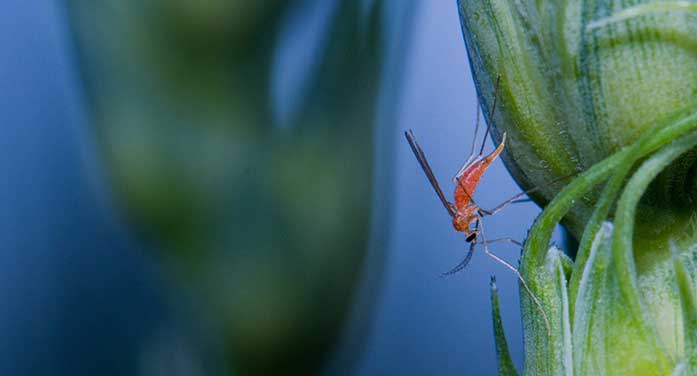Agricultural scientists in Western Canada are teaming up to give wheat a boost of built-in resistance to a destructive pest.
 James Harynuk |
 Boyd Mori |
 Alejandro Costamagna |
“Wheat midge is the number one insect pest threatening wheat crops across Western Canada,” says James Harynuk, a professor in the University of Alberta’s Faculty of Science.
Harynuk notes that wheat midge can cause about $60 million in damage to wheat crops in an average year. That number stretches to $300 million or more during bad seasons, with increasing wheat prices potentially raising that total even more.
The wheat midge damages wheat by laying its eggs in the kernels to hatch its larvae. And currently, there’s only one reliable genetic defence mechanism to protect wheat crops from this pest.
“Sm1 is a gene that can trigger a plant defence response which kills larvae feeding on wheat, but, right now, it’s the only tool we have available to us. We’re worried the midge might evolve resistance to it,” says Boyd Mori, an assistant professor in the Faculty of Agricultural, Life & Environmental Sciences.
That’s why a team of researchers is looking for a solution. Harynuk and co-lead Alejandro Costamagna from the University of Manitoba are looking for alternative traits or genes that will deter wheat midge from laying eggs, the same way Sm1 does. The $659,850 project is partly funded by Results Driven Agriculture Research (RDAR) and Genome Alberta’s Innovation in Agriculture Genomics Program.
“People have been searching for a resistance gene for a really long time,” says Mori, co-applicant on the project. “Since Sm1 in the 2000s, we just haven’t been able to find anything else.”
Mori explains that female wheat midge is deterred from particular strains of wheat because of the odour the wheat emits. “We’re looking to identify what those compounds are that the wheat is releasing to prevent wheat midge from laying eggs.”
To do this, Harynuk is examining the volatile organic compounds (VOCs) that wheat releases into the air. “A lot of these would be things like terpenes, terpenoids, the same kinds of compounds that contribute to flavour and aroma of plants,” he explains.
| RELATED CONTENT |
| Wheat makes the world go round By Pat Murphy |
| $2M boost for the development of new varieties of wheat By Bev Betkowski |
| How gene editing helps farmers and consumers By Sylvain Charlebois |
A pump pulls the air being sampled through a tube containing absorbent material that traps all those small molecules. Then the researchers use comprehensive two-dimensional gas chromatography to separate all the different types of molecules in the sample. These are identified and quantified using mass spectrometry.
The researchers will examine 40 wheat lines and take more than 3,000 VOC samples to determine which ones may help protect the wheat from the wheat midge. They will also look at the samples during both the day and the evening because wheat midge is most active at dusk and may have different behavioural patterns depending on the time of day.
Once the researchers identify which VOCs are responsible for preventing wheat midge from laying eggs and destroying wheat crops, they can use this crucial information to create new strains of wheat with protection against wheat midge.
While a temporary solution might involve some type of emitter device which slowly releases deterrent molecules, Harynuk explains that could become a huge burden in terms of cost and labour. The researchers are hoping their work will allow breeders to develop new lines of wheat that inherently generate deterrent molecules. This would allow farmers to easily keep wheat midge at bay simply by planting the new strains of wheat with built-in resistance.
“There’s something the plant is releasing that gets into the air and protects all the other plants in a certain radius,” explains Harynuk. That means the VOCs that deter wheat midge can also offer protection to the plants around them, and farmers wouldn’t necessarily need their wheat crop to be 100 per cent from a resistant line. It may be possible to protect a field by planting a blend of deterrent and non-deterrent wheat.
This comprehensive approach the researchers are taking also means the general framework they are using to determine which wheat lines would best deter wheat midge could potentially be applied to other plant and pest combinations.
“Other researchers could copy the formula we have, as long as they have the infrastructure to support the work, and find new and exciting ways to help improve agricultural yields with less of a reliance on pesticides,” says Harynuk.
“This is the sort of thing that could be a really big game-changer for the wheat industry and this pest.”
| By Adrianna MacPherson
Adrianna is a reporter with the University of Alberta’s Folio online magazine. The University of Alberta is a Troy Media Editorial Content Provider Partner.
The opinions expressed by our columnists and contributors are theirs alone and do not inherently or expressly reflect the views of our publication.
© Troy Media
Troy Media is an editorial content provider to media outlets and its own hosted community news outlets across Canada.


